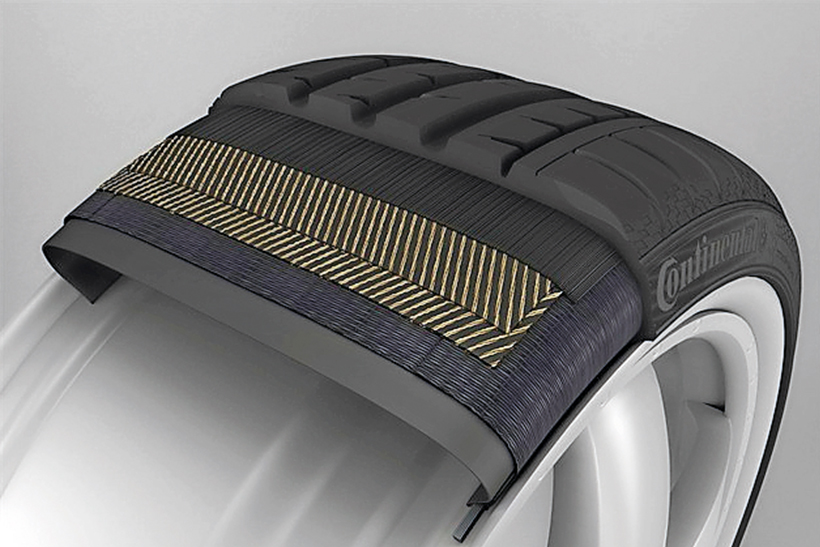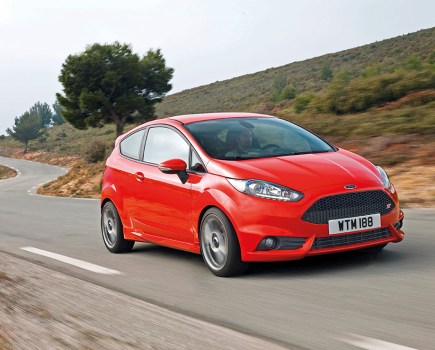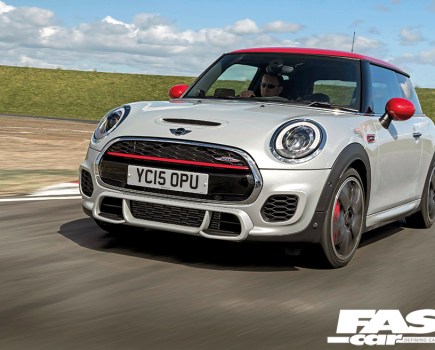When you think about it, no matter how much you’ve spent sorting out your pride and joy, there’s only ever four, small patches of rubber connecting it to the tarmac. It’s a sobering thought, and the reason tyres are one of the most important components on any vehicle, never mind on something built specifically for performance. But what should you be looking for in a set? How are they developed? And what do all those numbers mean? Well, allow is to explain…

BACK IN THE DAY
Early tyres (or ‘tires’ anywhere outside the UK) were simply iron bands wrapped around wooden cartwheels. The actual word ‘tire’ comes from the French ‘tirer’ which means ‘to pull’ – the way these bands would have been made by a blacksmith.
Anyway, rubber tyres came along much later with the first practical Pneumatic (air-filled) tyre being made by John Boyd Dunlop in 1887. Later developments in rubber vulcanisation by Charles Goodyear saw tougher, more durable compounds. Dunlop and Goodyear remain two of the world’s biggest tyre manufacturers to this day.

MODERN TYRE DEVELOPMENTS
With over a billion tyres produced every year, technology and development is one of the biggest parts of the industry. The modern car tyre is a completely different beast to the first ones that hit the streets – for a start modern tyres are black! Natural rubber is a kind of off-white colour, and so were early tyres until the addition of carbon black for durability, reinforcement and abrasion resistance. At first they’d just add carbon black to the treads, which is where white walls come from.
Nowadays, for the majority of cars at least, tyres are tubeless too. Natural rubber is porous, so modern construction now includes a layer to hold in the air, making inner tubes obsolete.

TYRE COMPOUNDS
Tyre technology and compound development is a thoroughly scientific and secret affair, making the business of manufacturing a far cry from just lobbing rubber in a mould. Each brand and model has a different make-up, that directly affects the amount of grip they can produce and how they work. It’s all down to application. There’s a reason Sebastian Vettel’s F1 car uses a different compound to your nan’s Micra!
Generally speaking, softer, sticky compounds, like those you’ll find in a performance tyre, will give far better grip, but will wear quicker. Conversely, a harder compound like you’ll find in a budget tyre will last forever, but give little confidence in the corners. For manufacturers it’s a balancing act between the two. There’s little point in having a super-grippy road tyre if it’s bald after 150 miles.

TYRE MATERIALS
The tyre industry is the biggest consumer of natural rubber on the planet and, along with carbon black, you have the majority of the tyre compound. The rest, as they say, is down to science and differs depending on the type of tyre produced. Some materials are closely- guarded secrets but a basic tyre will include silica for low heat build-up and reinforcement, sulphur for vulcanisation, zinc oxide as an activator, antioxidants to prevent sidewall cracking and some even add black chilli compound for improved grip and lower rolling resistance. Like I said, it’s pretty scientific stuff.

TYRE TREAD
From a performance point of view, the tread pattern, be it unidirectional, multi-directional, asymmetrical or any other word ending in “al”, is just there to dissipate water and increase traction in the wet. The general rule is that the more channels in the tread, the better it is at getting rid of surface water, while fewer channels will result in better grip in the dry.
Each part of the pattern is designed to channel water away from the contact patch, keeping what’s left of the rubber on the road. The blocks along the shoulder are separated by water-dispersing grooves called sipes. If you look at your own road tyres you’ll see these blocks are different sizes and are not as uniformly-spaced as you’d expect. They’re designed that way to avoid resonating – keep the noise down.
Compared with normal road tyres, road-legal track jobbies will have a minimum of grooves to keep as much rubber down on the tarmac for the best possible grip in the dry. The lack of grooves however means a relative lack of water clearance so they won’t be too clever in standing water. That’s exactly why patternless slicks are illegal on the road in the UK, but they come in handy on a dry track.

TYRE MANUFACTURING
Tyres are built in layers on a drum, and then cured in a huge press with heat and immense pressure to bond them all together. The vulcanisation process is a polymerisation reaction facilitated by all this heat, that links the rubber monomers creating huge elastic molecules. These polymers create the elastic quality that permits the tire to be compressed in the area where the tire contacts the road surface and spring back to its original shape. The makeup and shape has to be perfect for the tyre to work.

TYRE ANATOMY
BEAD
We hardly ever see this part of the tyre, but it’s essential for keeping it on the wheel. The bead, or inner edge, actually has a steel cord inside it and locks into the wheel rim under the pressure of the air inside. It’s subject to a great deal of wear throughout the tyre’s life as every movement the tyre makes rubs it against the rim. A lot of research goes into the compound of rubber covering the steel to cope with this.
BODY AND CAP PLY
Underneath the tread you’ll find a layer of material, then two layers of steel which make up its inner carcass. The fabric layer (cap ply) is made of nylon. The way these nylon elements are laid together are quite influential because they affect the amount of road noise. Steel belts (body ply) provide strength and rigidity, and run both across the tyre (from lip to lip) and in a criss-cross pattern. The carcass is completely incased in rubber.
OUTER CASING
The tyre is encased in the rubber compound affecting how hard and durable, or, soft and sticky the tyre is. It’s a question of juggling durability and performance to give a tyre that both lasts a reasonable length of time, and gets you round corners safely.
SHOULDER
The centrifugal forces acting on a spinning wheel and tyre tend to make the tyre want to ‘grow’, and this growth shows itself at the shoulder area. This is also the part of the tyre that works hard in corners, as the outside edge rolls further outwards due to the car’s weight. The shoulder area is made good and strong to counteract all these forces acting on it.
SIDEWALL
The sidewalls of the tyre have a say in both a car’s handling and its ride quality. Under hard cornering they’re designed to deform in such a way that leaves the tread as flat as possible on the road, that’s why a good stiff sidewall is needed. That said,a ridiculously stiff sidewall will give a harsh ride whereas a high sidewall will offer a more comfortable ride, but will flex more under cornering.
APEX
The area of lower sidewall just above the bead is of huge importance to how the sidewall performs. If there’s a great deal of material in it making the walls very stiff. Less apex material gives a softer sidewall. The trade-off is in the ride quality.


EU LABELS
Since November 2012 all tyres sold in the EU come with a standard eco-label showing just how noisy, good in the wet and fuel-efficient they are. Obviously the bit we’re interested in is the wet grip performance, imaginatively denoted here by a tyre and a rain cloud. Basically A is best and G will probably put you into a hedge backwards.
CHOOSING YOUR TYRES
DIRECTIONAL?
Most standard car tyres are non-directional with a symmetrical tread pattern over the whole width of the tyre. Performance tyres are usually directional because certain parts of the tread are adapted, making it asymmetric. Usually the outside edge will be given stiffer tread blocks for better cornering, while the inside will have smaller blocks designed to shift water, enhancing wet grip. The middle will also have a continuous rib, to help straight-line stability. If you’re running directional tyres make sure they’re fitted the right way round, if they’re not it’s an MoT failure.

PREMIUM VS BUDGET
The simple answer is don’t scrimp if you can help it. If you’ve never heard of the manufacturer, they’re probably crap and will be a liability, especially in winter. Obviously you’ll want to steer clear of those Cambodian Kojak radial ditch-finders because budget tyres (especially those in the smaller sizes) are made on mass, from rubbish compound and will be super-hard and badly designed. The manufacturer names don’t stick around very long either making them a bastard to match up. Big brands can do without the lawsuits so stick to them. If you know who they actually are then you’ll usually be golden.

WINTER TYRES
What’s that? It’s snowing! Well, you know what that means. At the mere sniff of ice the British roads grind to a halt. Now, obviously, you don’t see that in Europe but it’s all for good reason – they all run winter tyres (for many it’s compulsory). Normal road tyres don’t work as well under around 7-degrees Celsius, but this is where winter tyres are designed to be at their optimum. They’re tried and tested and are becoming more popular here every year. Contrary to popular belief, they don’t wear out quicker than summer tyres either. That’s not to say a good performance tyre doesn’t work in the winter, just that these are specifically designed to do the job.
DOWN-SIZING
In the quest for optimum handling it is common for modders to keep the same diameter rim but ‘downsize’ to lower profile tyres. Again this reduces sidewall flex but also decreases the rolling radius over standard. Some, especially in the old skool and Euro scenes, take it as far as running smaller wheels, often with low profile rubber too. This increases the acceleration potential of the car although, on the down side, the engine will be running at much higher revs at motorway speeds and the speedo will be slightly out.

PLUS-SIZING
Most of us will want to run aftermarket rims with a diameter an inch or two larger than standard. But to prevent fouling the arches or components, it’s sensible to keep the rolling radius, or the diameter of the wheels and tyres together, to as close to standard as possible. This is why as the size of the rim goes up, generally the profile of the tyre will become shorter. To an extent, running slightly larger wheels with lower profile tyres can improve your car’s handling too. This is because increasing the size of rigid alloy and reducing the rubber sidewall will cut down on tyre flex.







